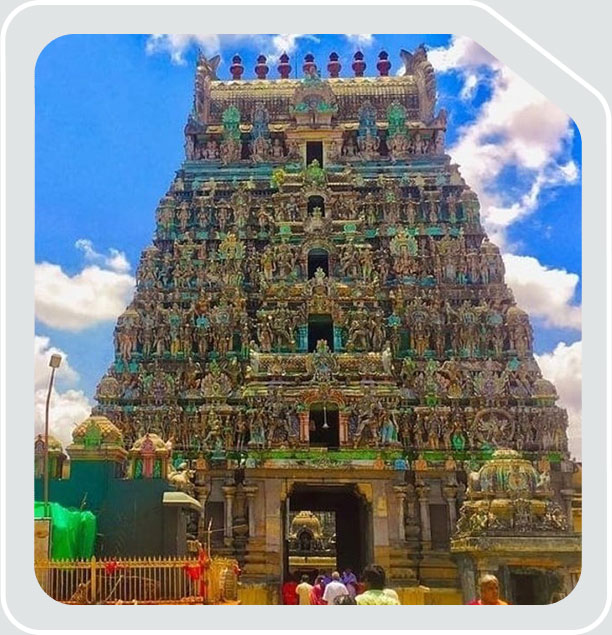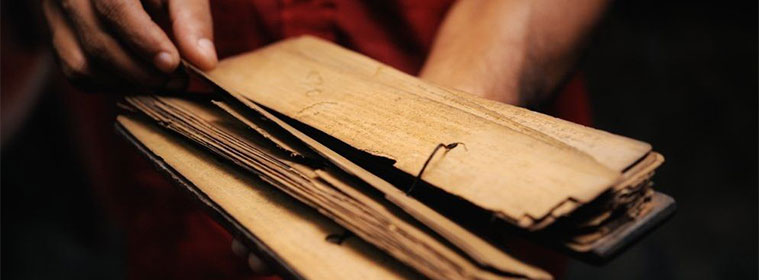
When one steps into the Vaitheeswaran Temple one gets the feeling of stepping into a divine world-built century ago. The calm environs of this temple heal both body and mind of devotees.
This temple is popularly known as Vaitheeswaran Koil and it stands as a revered sanctuary. The beautiful environs of the temple is nestled between Sirkazhi and Mayiladuthurai in Nagapattinam district of Tamil Nadu.
Built almost 1000 years ago this ancient Hindu temple, dedicated to Lord Vaidyanathar (Lord of Healing and Divine Physician) and His Consort Thaiyal Nayagi (The Mother who can sew up wounds), holds a unique place in our collective spiritual landscape. The temple also is famous for Lord Muruga who is named as Selva Muthukumaran and is also one of the Navagraha Temples for Mars (Angaraka)
Call Us 24/7
The temple is majestic and has another shrine for Muruga, Vinayaka, Balambal and Shiva lingam. This temple features bronze statues of Nataraja, Angaraka, Jatayu and others. With a history steeped in folklore and a reputation as a center for healing, this sacred place draws devotees from all corners of the India and even the world. Here we embark on a journey to explore the rich tapestry of Vaitheeswaran Koil, uncovering its history, spiritual significance, healing traditions, and architectural marvels.
In one of the mythological tales it is mentioned that it was at this very location that Lord Rama, the seventh avatar of Lord Vishnu, performed the last rites of Jatayu, the noble vulture who valiantly fought to rescue Sita from the clutches of Ravana. This sacred act by Lord Rama sanctified the land and made it a focal point for spiritual seekers.
This temple is renowned for its mystical healing powers and spiritual significance. Lord Vaitheeswaran – the names mean Vaidya or healing and Eswaran or Shiva. Therefore, it means Lord Shiva who has assumed the role of a physician or healer. His Consort is Thaiyal Nayagi – this means the Divine Mother who can sew the wounds of those who are injured. Together along with their son Muthu Kumaran they will cure diseases and those devotees who visit this temple with faith and hope will bear testimony to the miraculous healing they experience.
The mystical healing powers and spiritual significance of Vaitheeswaran Koil are deeply rooted in the temple’s sacred history and the divine presence of Lord Vaitheeswaran, who is revered as the God of Healing. Lord Vaitheeswaran’s exceptional healing abilities are believed to have emanated from a remarkable legend associated with the temple.
According to Hindu mythology, Mars, known as Angarakan, was afflicted by a severe case of leprosy. Tormented by this ailment, Angarakan fervently prayed to Lord Shiva at Vaitheeswaran Koil, seeking a cure for his affliction. Touched by his devotion, Lord Shiva blessed Angarakan, miraculously healing him from the leprosy. In gratitude, Angarakan took up residence in the temple as one of the nine celestial planets (Navagrahas), with Vaitheeswaran Koil being his abode.
This captivating legend has bestowed upon Lord Vaitheeswaran the unique ability to cure ailments, particularly skin diseases, leprosy, and other health-related issues. Devotees from far and wide visit this sacred temple, seeking solace and healing. The temple complex houses various sanctified ponds, including Siddhamritha Teerth and Jatayukundam, where pilgrims believe that taking a dip can cleanse their sins and purify their bodies, paving the way for healing.
To offer worship at Vaitheeswaran Koil, devotees often perform rituals involving the presentation of Arali flowers and the offering of salt mixed with jaggery, symbolizing the act of seeking healing from Lord Vaitheeswaran. The temple’s sanctum sanctorum is a sacred space where devotees can offer their prayers and seek blessings for good health and overall well-being. It is customary to walk around the temple’s inner prakaram (circumambulatory path) to express devotion and seek divine intervention.
In summary, Vaitheeswaran Koil’s mystical healing powers and spiritual significance are deeply intertwined with the divine legend of Lord Vaitheeswaran’s miraculous healing of Angarakan. Devotees believe that the temple’s sacred waters and rituals hold the key to physical and spiritual healing, making it a revered pilgrimage site for those seeking remedies and solace from various ailments.
Vaitheeswaran Temple is renowned for its pantheon of deities, each possessing unique powers and attributes that cater to various spiritual and healing needs. Here is a detailed note about some of the prominent deities at the temple, their powers, and how to worship them:
Lord Vaitheeswaran, the presiding deity of the temple, is the divine physician and healer. His blessings are sought for curing ailments and promoting overall health. He is believed to have the power to heal both physical and mental afflictions.
Devotees offer prayers and perform abhishekam (ritual bathing) to Lord Vaitheeswaran using various substances like milk, honey, and sandalwood paste. Lighting lamps and offering bilva leaves and sacred ash (vibhuti) are common practices to seek his blessings for health and well-being.
Thaiyalnayaki, also known as Thiyalnayagi, is a manifestation of the Divine Mother. She is believed to possess the power to heal diseases and ailments, particularly skin-related issues. Her presence signifies the nurturing and caring aspect of the Divine Feminine.
Devotees approach Thaiyalnayaki with offerings of medicinal oil, which is believed to have healing properties. Lighting ghee lamps and reciting her sacred mantras are common practices to seek her grace for skin-related health concerns.
Lord Subramanya is revered as the God of valor and courage. He is believed to protect devotees from malefic influences and grant them strength and determination to overcome obstacles.
Devotees offer prayers and light lamps in front of the shrine of Lord Subramanya. Offering sacred ash (vibhuti) is also a common practice, symbolizing protection and spiritual strength.
Lord Angaraka, associated with the planet Mars, is believed to influence one’s energy, drive, and assertiveness. Devotees seek his blessings to alleviate the negative effects of Mars dosha (Kuja dosha) in their astrological charts.
Worshipers perform special pujas and rituals to Lord Angaraka to appease him and mitigate the adverse effects of Mars dosha. Offering red flowers, red silk, and lighting a lamp with red oil are customary practices for propitiating Lord Angaraka.
Lord Dhanvantari is the divine physician of the gods and is associated with the knowledge of Ayurveda. Devotees invoke his blessings for good health and the prevention of diseases.
Offerings of sacred herbs, medicinal oils, and Ayurvedic preparations are made to Lord Dhanvantari. Chanting his mantras and seeking his guidance for holistic well-being are part of the worship.
Devotees at Vaitheeswaran Temple often engage in a series of rituals and pujas to invoke the blessings of these deities, depending on their specific needs and health concerns. The temple’s healing powers are deeply intertwined with the faith and devotion of its visitors, making it a significant center for spiritual and physical healing.
The Vaitheeswaran Temple stands as the cradle of Nadi astrology, also known as ‘நாடி ஜோதிடம்’ in Tamil or ‘nāḍi jyotiṣha’ in Sanskrit. This ancient and profound form of Hindu astrology finds its roots intertwined with the temple’s sacred history. It is founded upon the profound belief that the destinies of all individuals, spanning their past, present, and future lives, were meticulously foreseen and meticulously recorded by revered Hindu sages in times of antiquity.
The Nadi texts, written in the ancient Tamil script known as Vatteluttu, are a testament to the spiritual wisdom and foresight of these ancient seers. Among the various schools of thought regarding the authorship of these remarkable leaves, they are predominantly attributed to a revered Tamil sage named Agathiyar. Legend has it that Agathiyar received divine revelations, granting him the extraordinary ability to peer into the tapestry of human destinies.
These invaluable Nadi leaves, the repository of countless life narratives, were originally safeguarded within the hallowed confines of the Tanjore Saraswati Mahal Library in Tamil Nadu. During the era of British colonial rule, the British rulers exhibited interest in specific Nadi leaves, particularly those associated with herbs, medicine, and future predictions. However, most of these profound texts remained safeguarded within the library’s sanctum, accessible only to a select few.
Tragically, some of these ancient leaves succumbed to the ravages of time and were lost forever, while others found their way into the hands of private collectors through auctions conducted during the British colonial period. Nonetheless, a significant number of these precious Nadi leaves found their way into the possession of dedicated astrologers and families residing in the vicinity of the Vaitheeswaran Temple. Over generations, this priceless legacy of knowledge and divination has been carefully preserved and handed down from one custodian to the next, ensuring that the profound tradition of Nadi astrology continues to thrive at its place of origin, the sacred Vaitheeswaran Temple.
It is located 7 kilometers from Sirkazhi, 235 kilometers from Chennai, 27 km from Chidambaram, 110 km from Thanjavur and 16 km from Mayiladuthurai.
Tamil Nadu is situated 2,293.9 km away from Delhi, so it is wise to travel either by train or by flight. To reach them, follow the instructions mentioned below:
By Train
The rail system in Tamil Nadu has excellent connectivity to other parts of India. When traveling to India from abroad, you can commute from Delhi and Mumbai to Tamil Nadu via the Tamil Nadu Express and Chennai Express. However, there are numerous other local and fast trains that travel to Chennai from places like Punjab, Rajasthan, and Andhra Pradesh.
By Air Borne
The state of Tamil Nadu has an airport in the heart of its capital, Chennai Airport. There is a regular flight network to Tamil Nadu from various states. This is the fastest and most convenient way to reach this state and enjoy a visit to Vaitheeswaran temple, Kumbakonam. A direct flight from Delhi to Chennai Airport takes around 2 hours and 50 minutes. Don’t forget to go through the Vaitheeswaran temple timings before booking a flight.

Call Us 24/7